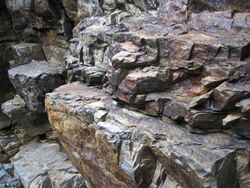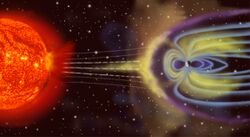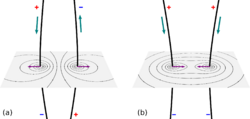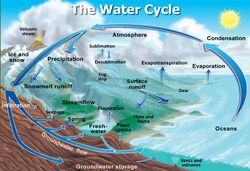Earth:Earth science

Earth science or geoscience includes all fields of natural science related to the planet Earth. This is a branch of science dealing with the physical, chemical, and biological complex constitutions and synergistic linkages of Earth's four spheres, namely biosphere, hydrosphere, atmosphere, and geosphere. Earth science can be considered to be a branch of planetary science, but with a much older history. Earth science encompasses four main branches of study, the lithosphere, the hydrosphere, the atmosphere, and the biosphere, each of which is further broken down into more specialized fields.
There are both reductionist and holistic approaches to Earth sciences. It is also the study of Earth and its neighbors in space. Some Earth scientists use their knowledge of the planet to locate and develop energy and mineral resources. Others study the impact of human activity on Earth's environment, and design methods to protect the planet. Some use their knowledge about Earth processes such as volcanoes, earthquakes, and hurricanes to plan communities that will not expose people to these dangerous events.
Earth sciences can include the study of geology, the lithosphere, and the large-scale structure of Earth's interior, as well as the atmosphere, hydrosphere, and biosphere. Typically, Earth scientists use tools from geology, chronology, physics, chemistry, geography, biology, and mathematics to build a quantitative understanding of how Earth works and evolves. For example, meteorologists study the weather and watch for dangerous storms. Hydrologists examine water and warn of floods. Seismologists study earthquakes and try to understand where they will strike. Geologists study rocks and help to locate useful minerals. Earth scientists often work in the field—perhaps climbing mountains, exploring the seabed, crawling through caves, or wading in swamps. They measure and collect samples (such as rocks or river water), then record their findings on charts and maps.
Geology

Geology is the study of the lithosphere, or Earth's surface, including the crust and rocks. It includes the physical characteristics and processes that occur in the lithosphere as well as how they are affected by geothermal energy. It incorporates aspects of chemistry, physics, and biology as elements of geology interact. Historical geology is the application of geology to interpret Earth's history and how it changes over time. Geochemistry studies the chemical components and processes of the Earth. Geophysics studies the physical properties of the lithosphere. Paleontology studies fossilized biological material in the lithosphere. Planetary geology studies geology as it pertains to extraterrestrial bodies. Geomorphology studies the origin of landscapes. Structural geology studies the deformation of rocks to produce mountains and lowlands. Resource geology studies how energy resources can be obtained from minerals. Environmental geology studies how pollution and contaminates affect soil and rock.[1] Mineralogy is the study of minerals. It includes the study of mineral formation, crystal structure, hazards associated with minerals, and the physical and chemical properties of minerals.[2] Petrology is the study of rocks, including the formation and composition of rocks. Petrography is a branch of petrology that studies the typology and classification of rocks.[3]
Earth's interior
This section may stray from the topic of the article. (August 2022) |

Plate tectonics, mountain ranges, volcanoes, and earthquakes are geological phenomena that can be explained in terms of physical and chemical processes in the Earth's crust.[5] Beneath the Earth's crust lies the mantle which is heated by the radioactive decay of heavy elements. The mantle is not quite solid and consists of magma which is in a state of semi-perpetual convection. This convection process causes the lithospheric plates to move, albeit slowly. The resulting process is known as plate tectonics.[6][7][8][9] Areas of the crust where new crust is created are called divergent boundaries, those where it is brought back into the Earth are convergent boundaries and those where plates slide past each other, but no new lithospheric material is created or destroyed, are referred to as transform (or conservative) boundaries[7][9][10] Earthquakes result from the movement of the lithospheric plates, and they often occur near convergent boundaries where parts of the crust are forced into the earth as part of subduction.[11]
Plate tectonics might be thought of as the process by which the Earth is resurfaced. As the result of seafloor spreading, new crust and lithosphere is created by the flow of magma from the mantle to the near surface, through fissures, where it cools and solidifies. Through subduction, oceanic crust and lithosphere returns to the convecting mantle.[7][9][12] Volcanoes result primarily from the melting of subducted crust material. Crust material that is forced into the asthenosphere melts, and some portion of the melted material becomes light enough to rise to the surface—giving birth to volcanoes.[7][11]
Atmospheric science

(image not to scale.)
Atmospheric science initially developed in the late-19th century as a means to forecast the weather through meteorology, the study of weather. Atmospheric chemistry was developed in the 20th century to measure air pollution and expanded in the 1970s in response to acid rain. Climatology studies the climate and climate change.[13]
The troposphere, stratosphere, mesosphere, thermosphere, and exosphere are the five layers which make up Earth's atmosphere. 75% of the gases in the atmosphere are located within the troposphere, the lowest layer. In all, the atmosphere is made up of about 78.0% nitrogen, 20.9% oxygen, and 0.92% argon, and small amounts of other gases including CO2 and water vapor.[14] Water vapor and CO2 allow the Earth's atmosphere to catch and hold the Sun's energy through the greenhouse effect.[15] This allows Earth's surface to be warm enough to have liquid water and support life. In addition to storing heat, the atmosphere also protects living organisms by shielding the Earth's surface from cosmic rays—which are often incorrectly thought to be deflected by the magnetic field.[16] The magnetic field—created by the internal motions of the core—produces the magnetosphere which protects Earth's atmosphere from the solar wind.[17] As the Earth is 4.5 billion years old,[18] it would have lost its atmosphere by now if there were no protective magnetosphere.
Earth's magnetic field
This section may stray from the topic of the article. (August 2022) |

thumb|Changing magnetic field through a coil of wire therefore must induce an EMF the coil which in turn causes current to flow.[19]An electromagnet is a magnet that is created by an electric current.[20] The Earth has a solid iron inner core surrounded by a fluid outer core that convects;[21] therefore, Earth is an electromagnet. The motion of fluid convection sustains the Earth's magnetic field.[21][22]
The magnetic field is also very important because some birds and insects use it to navigate over long distances, using the magnetized iron crystals found in their skin. The most important function of Earth's magnetic field is protecting its organisms. High energy protons are deflected along with electrons in the solar wind. If organisms were directly exposed to these particles it would be lethal.[23] For the consistency[clarification needed] of a magnetic field to remain constant there must be an attractive magnetic field.[clarification needed] If the motion of a magnetic field changes then every aspect of it does as well.[clarification needed] It indicates a force that is proportional to the velocity of a moving charge.[24]
Magnetic flux density is generally measured in teslas. Another unit sometimes used is the gauss (G). 1 G is equivalent to 10−4 T (or 1 mG = 0.1µT).
The Lorentz Force Law
The force exerted by a magnetic field on an object can be defined by the Lorentz Law.
where
- F is the force
- q is the object's electric charge
- E is the electric field
- v is the object's velocity
- B is the magnetic field strength.
The electromagnetic force holds atoms and molecules together. In fact, at this scale the forces of electric attraction and repulsion of electric charges are so dominant over the other three fundamental forces that they can be considered to be negligible as determiners of atomic and molecular structure.[25]
The Lorentz Force Law was named after Dutch physicist Hendrik Antoon Lorentz. He was the first to formulate this equation. Lorentz theorized that atoms might consist of charged particles and suggested that the oscillations of these charged particles were the source of light.[26]
Hydrology

Hydrology is the study of the hydrosphere and the movement of water on Earth. It emphasizes the study of how humans use and interact with freshwater supplies. Study of water's movement is closely related to geomorphology and other branches of Earth science. Applied hydrology involves engineering to maintain aquatic environments and distribute water supplies. Subdisciplines of hydrology include oceanography, hydrogeology, ecohydrology, and glaciology. Oceanography is the study of oceans.[27] Hydrogeology is the study of groundwater. It includes the mapping of groundwater supplies and the analysis of groundwater contaminants. Applied hydrogeology seeks to prevent contamination of groundwater and mineral springs and make it available as drinking water. The earliest exploitation of groundwater resources dates back to 3000 BC, and hydrogeology as a science was developed by hydrologists beginning in the 17th century.[28] Ecohydrology is the study of ecological systems in the hydrosphere. It can be divided into the physical study of aquatic ecosystems and the biological study of aquatic organisms. Ecohydrology includes the effects that organisms and aquatic ecosystems have on one another as well as how these ecoystems are affected by humans.[29] Glaciology is the study of the cryosphere, including glaciers and coverage of the Earth by ice and snow. Concerns of glaciology include access to glacial freshwater, mitigation of glacial hazards, obtaining resources that exist beneath frozen land, and addressing the effects of climate change on the cryosphere.[30]
Ecology
Ecology is the study of the biosphere. This includes the study of nature and of how living things interact with the Earth and one another. It considers how living things use resources such as oxygen, water, and nutrients from the Earth to sustain themselves. It also considers how humans and other living creatures cause changes to nature.[31]
Physical geography
Physical geography is the study of Earth's systems and how they interact with one another as part of a single self-contained system. It incorporates astronomy, mathematical geography, meteorology, climatology, geology, geomorphology, biology, biogeography, pedology, and soils geography. Physical geography is distinct from human geography, which studies the human populations on Earth, though it does include human effects on the environment.[32]
Methodology
Methodologies vary depending on the nature of the subjects being studied. Studies typically fall into one of three categories: observational, experimental, or theoretical. Earth scientists often conduct sophisticated computer analysis or visit an interesting location to study earth phenomena (e.g. Antarctica or hot spot island chains).
A foundational idea in Earth science is the notion of uniformitarianism, which states that "ancient geologic features are interpreted by understanding active processes that are readily observed." In other words, any geologic processes at work in the present have operated in the same ways throughout geologic time. This enables those who study Earth's history to apply knowledge of how Earth processes operate in the present to gain insight into how the planet has evolved and changed throughout long history.
Earth's spheres
Earth science generally recognizes four spheres, the lithosphere, the hydrosphere, the atmosphere, and the biosphere;[33] these correspond to rocks, water, air and life. Also included by some are the cryosphere (corresponding to ice) as a distinct portion of the hydrosphere and the pedosphere (corresponding to soil) as an active and intermixed sphere. The following fields of science are generally categorized within the Earth sciences:
- Geology describes the rocky parts of the Earth's crust (or lithosphere) and its historic development. Major subdisciplines are mineralogy and petrology, geomorphology, paleontology, stratigraphy, structural geology, engineering geology, and sedimentology.[34][35]
- Physical geography focuses on geography as an Earth science. Physical geography is the study of Earth's seasons, climate, atmosphere, soil, streams, landforms, and oceans. Physical geography can be divided into several branches or related fields, as follows: geomorphology, biogeography, environmental geography, palaeogeography, climatology, meteorology, coastal geography, hydrology, ecology, glaciology.[citation needed]
- Geophysics and geodesy investigate the shape of the Earth, its reaction to forces and its magnetic and gravity fields. Geophysicists explore the Earth's core and mantle as well as the tectonic and seismic activity of the lithosphere.[35][36][37] Geophysics is commonly used to supplement the work of geologists in developing a comprehensive understanding of crustal geology, particularly in mineral and petroleum exploration. Seismologists use geophysics to understand plate tectonic shifting, as well as predict seismic activity.
- Geochemistry is defined as the study of the processes that control the abundance, composition, and distribution of chemical compounds and isotopes in geologic environments. Geochemists use the tools and principles of chemistry to study the composition, structure, processes, and other physical aspects of the Earth. Major subdisciplines are aqueous geochemistry, cosmochemistry, isotope geochemistry and biogeochemistry.
- Soil science covers the outermost layer of the Earth's crust that is subject to soil formation processes (or pedosphere).[38] Major subdivisions in this field of study include edaphology and pedology.[39]
- Ecology covers the interactions between organisms and their environment. This field of study differentiates the study of Earth from the study of other planets in the Solar System, Earth being its only planet teeming with life.
- Hydrology, oceanography and limnology are studies which focus on the movement, distribution, and quality of the water and involves all the components of the hydrologic cycle on the Earth and its atmosphere (or hydrosphere). "Sub-disciplines of hydrology include hydrometeorology, surface water hydrology, hydrogeology, watershed science, forest hydrology, and water chemistry."[40]
- Glaciology covers the icy parts of the Earth (or cryosphere).
- Atmospheric sciences cover the gaseous parts of the Earth (or atmosphere) between the surface and the exosphere (about 1000 km). Major subdisciplines include meteorology, climatology, atmospheric chemistry, and atmospheric physics.
Earth science breakup
- Hydrology
- Limnology (freshwater science)
- Oceanography (marine science)
- Chemical oceanography
- Physical oceanography
- Biological oceanography (marine biology)
- Geological oceanography (marine geology)
- Geology
- Geography
- Geochemistry
- Geomorphology
- Geophysics
- Geochronology
- Geodynamics (see also Tectonics)
- Geomagnetism
- Gravimetry (also part of Geodesy)
- Seismology
- Glaciology
- Hydrogeology
- Mineralogy
- Petrology
- Speleology
- Volcanology
- Systems
- Earth system science
- Environmental science
- Geography
- Gaia hypothesis
- Systems ecology
- Systems geology
- Others
- Geography
- Cartography
- Geoinformatics (GIScience)
- Geostatistics
- Geodesy and Surveying
- Remote Sensing
- Nanogeoscience
See also
- American Geosciences Institute
- Earth sciences graphics software
- Glossary of geology terms
- List of Earth scientists
- List of geoscience organizations
- List of unsolved problems in geoscience
- Making North America (2015 PBS film)
- National Association of Geoscience Teachers
- Solid-earth science
- Science tourism
- Structure of the Earth
References
- ↑ Smith & Pun 2006, pp. 14–16.
- ↑ Haldar 2020, p. 109.
- ↑ Haldar 2020, p. 145.
- ↑ Encyclopedia of Volcanoes, Academic Press, London, 2000
- ↑ "Earth's Energy Budget". ou.edu. http://okfirst.ocs.ou.edu/train/meteorology/EnergyBudget.html.
- ↑ Simison 2007, paragraph 7
- ↑ 7.0 7.1 7.2 7.3 Adams & Lambert 2006, pp. 94–95, 100, 102
- ↑ Smith & Pun 2006, pp. 13–17, 218, G-6
- ↑ 9.0 9.1 9.2 Oldroyd 2006, pp. 101, 103, 104
- ↑ Smith & Pun 2006, p. 331
- ↑ 11.0 11.1 Smith & Pun 2006, pp. 325–26, 329
- ↑ Smith & Pun 2006, p. 327
- ↑ Wallace, John M.; Hobbs, Peter V. (2006). Atmospheric Science: An Introductory Survey (2nd ed.). Elsevier Science. pp. 1–3. ISBN 9780080499536.
- ↑ Adams & Lambert 2006, pp. 107–08
- ↑ American Heritage, p. 770
- ↑ Parker, Eugene (March 2006), Shielding Space, Scientific American, https://engineering.dartmouth.edu/~d76205x/research/Shielding/docs/Parker_06.pdf
- ↑ Adams & Lambert 2006, pp. 21–22
- ↑ Smith & Pun 2006, p. 183
- ↑ "Introduction to Magnetism and Induced Currents". https://www.rpi.edu/dept/phys/ScIT/InformationStorage/faraday/magnetism_a.html.
- ↑ American Heritage, p. 576
- ↑ 21.0 21.1 Oldroyd 2006, p. 160
- ↑ Demorest, Paul (2001-05-21). "Dynamo Theory and Earth's Magnetic Field.". http://setiathome.berkeley.edu/~pauld/etc/210BPaper.pdf.
- ↑ Christensen, Norman L. (2019). The Environment and you. Lissa Leege, Justin St. Juliana (Third ed.). NY, NY. ISBN 978-0-13-464605-3. OCLC 1007498917. https://www.worldcat.org/oclc/1007498917.
- ↑ Hughes, Scott (10 March 2005). "Massachusetts Institute of Technology Department of Physics 8.022 Spring 2004 Lecture 10: Magnetic force; Magnetic fields; Ampere's law". https://web.mit.edu/sahughes/www/8.022/lec10.pdf.
- ↑ "Fundamental Forces". http://hyperphysics.phy-astr.gsu.edu/hbase/Forces/funfor.html#c3.
- ↑ "The Nobel Prize in Physics 1902" (in en-US). https://www.nobelprize.org/prizes/physics/1902/lorentz/biographical/.
- ↑ Davie, Tim; Quinn, Nevil Wyndham (2019). Fundamentals of Hydrology (3rd ed.). Routledge. pp. 1–2. ISBN 9780203798942.
- ↑ Hölting, Bernward; Coldewey, Wilhelm G. (2019). "Introduction". Hydrogeology (8th ed.). Springer. pp. 1–3. doi:10.1007/978-3-662-56375-5. ISBN 9783662563755. https://link.springer.com/book/10.1007/978-3-662-56375-5.
- ↑ Wood, Paul J.; Hannah, David M.; Sadler, Jonathan P. (2007). "Ecohydrology and Hydroecology: An Introduction". Hydroecology and Ecohydrology: Past, Present and Future. Wiley. pp. 1–6. ISBN 9780470010174.
- ↑ Knight, Peter (1999). Glaciers. Taylor & Francis. pp. 1. ISBN 9780748740000.
- ↑ Ricklefs, Robert E.; Miller, Gary L. (2000). Ecology (4th ed.). W. H. Freeman. pp. 3–4. ISBN 9780716728290.
- ↑ Petersen, James F.; Sack, Dorothy; Gabler, Robert E. (2014). Fundamentals of Physical Geography. Cengage Learning. pp. 2–3. ISBN 9781285969718.
- ↑ Earth's Spheres . ©1997–2000. Wheeling Jesuit University/NASA Classroom of the Future. Retrieved November 11, 2007.
- ↑ Adams & Lambert 2006, p. 20
- ↑ 35.0 35.1 Smith & Pun 2006, p. 5
- ↑ "WordNet Search – 3.1". princeton.edu. http://wordnetweb.princeton.edu/perl/webwn?s=geodesy&sub=Search+WordNet&o2=&o0=1&o7=&o5=&o1=1&o6=&o4=&o3=&h=0.
- ↑ "NOAA National Ocean Service Education: Global Positioning Tutorial". noaa.gov. http://www.oceanservice.noaa.gov/education/kits/geodesy/welcome.html.
- ↑ Elissa Levine, 2001, The Pedosphere As A Hub broken link?
- ↑ Gardiner, Duane T. "Lecture 1 Chapter 1 Why Study Soils?". ENV320: Soil Science Lecture Notes. Texas A&M University-Kingsville. http://jan.ucc.nau.edu/~doetqp-p/courses/env320/lec1/Lec1.html.
- ↑ Craig, Kendall. "Hydrology of the Watershed". http://www.flatheadwatershed.org/watershed/hydrology.shtml.
Sources
- Adams, Simon; Lambert, David (2006). Earth Science: An illustrated guide to science. New York, NY: Chelsea House. ISBN 978-0-8160-6164-8.
- Haldar, S. K. (2020). Introduction to Mineralogy and Petrology (2nd ed.). Elsevier Science. ISBN 9780323851367.
- Joseph P. Pickett (executive editor) (1992). American Heritage dictionary of the English language (4th ed.). Boston, MA: Houghton Mifflin Company. ISBN 978-0-395-82517-4. https://archive.org/details/americanheritage0000unse_a1o7.
- Simison, W. Brian (2007-02-05). "The mechanism behind plate tectonics". http://www.ucmp.berkeley.edu/geology/tecmech.html.
- Smith, Gary A.; Pun, Aurora (2006). How Does the Earth Work? Physical Geology and the Process of Science. Upper Saddle River, NJ: Pearson Prentice Hall. ISBN 978-0-13-034129-7.
- Oldroyd, David (2006). Earth Cycles: A historical perspective. Westport, CT: Greenwood Press. ISBN 978-0-313-33229-6.
Further reading
- Allaby M., 2008. Dictionary of Earth Sciences, Oxford University Press, ISBN 978-0-19-921194-4
- Korvin G., 1998. Fractal Models in the Earth Sciences, Elsvier, ISBN 978-0-444-88907-2
- "Earth's Energy Budget". Oklahoma Climatological Survey. 1996–2004. http://okfirst.mesonet.org/train/meteorology/EnergyBudget.html.
- Miller, George A.; Christiane Fellbaum (2006). "WordNet Search 3.0". WordNet a lexical database for the English language. Princeton, NJ: Princeton University/Cognitive Science Laboratory. http://wordnetweb.princeton.edu/perl/webwn?s=Earth+science&sub=Search+WordNet&o2=&o0=1&o7=&o5=&o1=1&o6=&o4=&o3=&h=0.
- "NOAA National Ocean Service Education: Geodesy". National Oceanic and Atmospheric Administration. 2005-03-08. http://www.oceanservice.noaa.gov/education/kits/geodesy/welcome.html.
- Reed, Christina (2008). Earth Science: Decade by Decade. New York, NY: Facts on File. ISBN 978-0-8160-5533-3.
- Tarbuck E. J., Lutgens F. K., and Tasa D., 2002. Earth Science, Prentice Hall, ISBN 978-0-13-035390-0
External links
- Earth Science Picture of the Day, a service of Universities Space Research Association, sponsored by NASA Goddard Space Flight Center.
- Geoethics in Planetary and Space Exploration.
- Geology Buzz: Earth Science
 |

